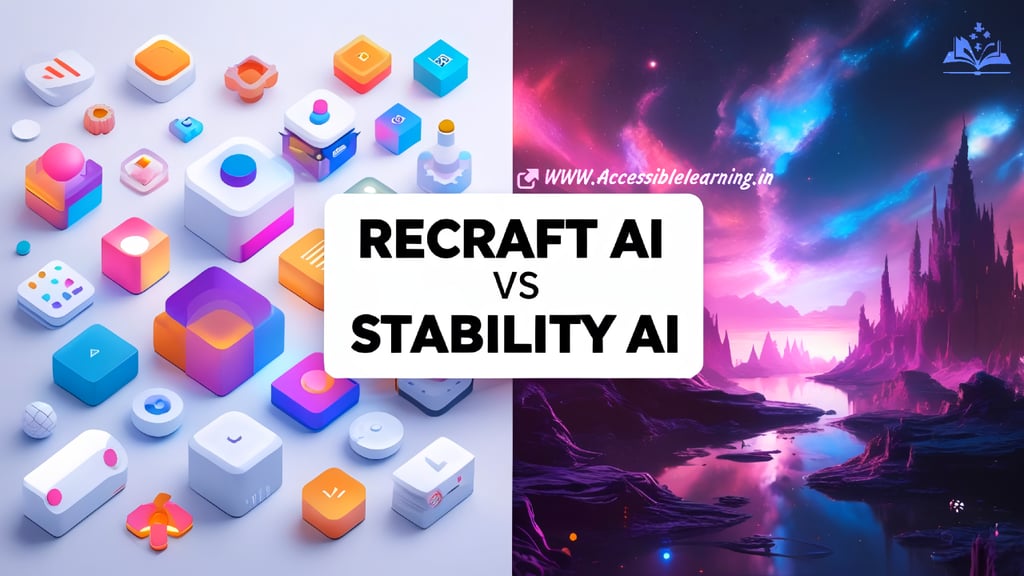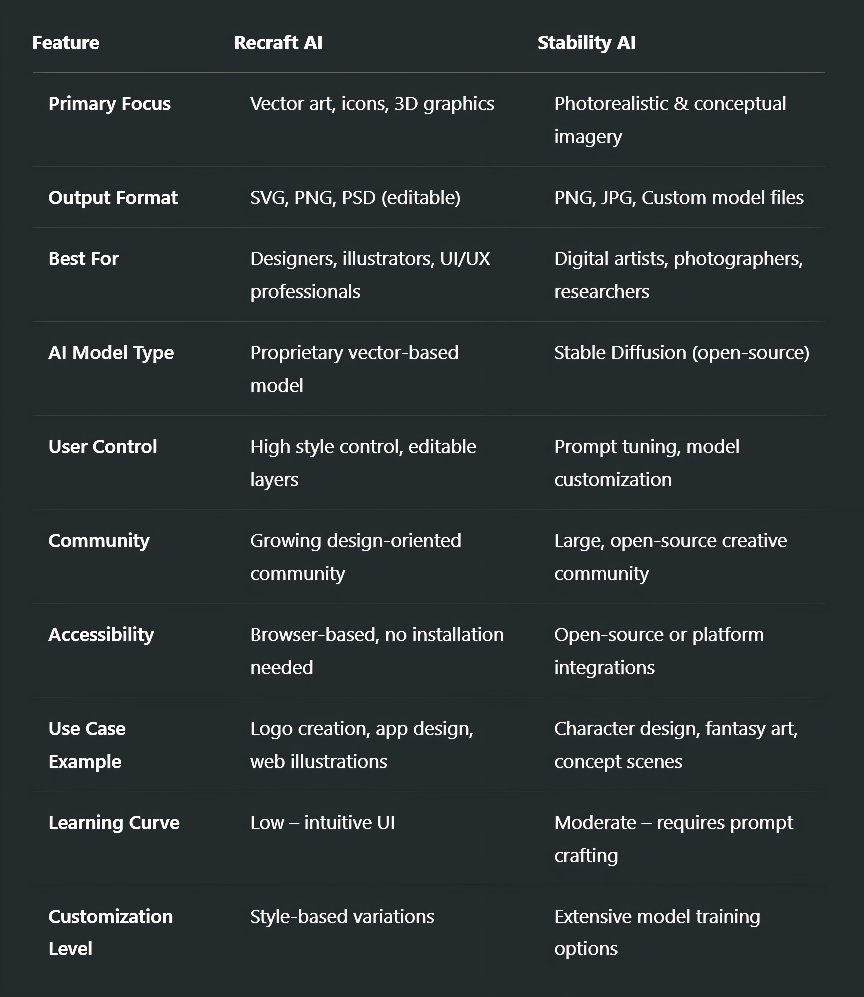
Recraft AI vs Stability AI: Which Creative Tool Should You Choose in 2025?
Explore the key differences between Recraft AI and Stability AI—two powerhouse tools in generative art. Learn which platform best suits your creative workflow, from editable vector graphics to photorealistic imagery, with advanced and technical insights.
ARTIST/CREATIVITYAI ART TOOLSEDITOR/TOOLSAI/FUTURE
Sachin K Chaurasiya
4/17/20254 min read


In the ever-evolving world of artificial intelligence, two platforms are standing out in the creative domain: Recraft AI and Stability AI. Both tools are designed to assist creators, artists, and designers, but they do so in very different ways. Whether you're a digital artist looking to generate vector-based designs or a creative professional experimenting with photorealistic imagery, understanding these two platforms is essential to choosing the right one for your needs.
What is Recraft AI?
Recraft AI is a powerful browser-based design tool that leverages generative AI to create high-quality vector art, icons, illustrations, and 3D graphics. Its main appeal lies in its ability to generate scalable and editable designs, making it a go-to tool for UI/UX designers, brand developers, and digital illustrators.
Key Features
Vector-Based Outputs: Ideal for logos, illustrations, and UI elements.
Style Control: Users can refine output styles with high precision.
Editable Layers: Outputs can be tweaked using tools like Figma or Illustrator.
AI Prompting: Describe your vision in text, and Recraft generates it.
Commercial Use: Designed with licensing clarity for professional projects.
Built-in Templates: Offers starter layouts to help speed up workflows.
Design Feedback Loop: Real-time editing and iteration features.
Strengths
Vector-Based Precision: Creates clean, scalable graphics ideal for branding and UI/UX.
Editable Outputs: Supports PSD, SVG, and layered exports for post-editing in Figma or Illustrator.
User-Friendly Interface: Low learning curve; perfect for designers without AI expertise.
Brand Consistency Tools: Great for maintaining a unified visual identity across campaigns.
Commercial Licensing: Output is safe for use in client and professional projects.
Weaknesses
Limited Photorealism: Not suitable for hyper-realistic or painterly art styles.
Closed Source: Offers less flexibility for developers or AI researchers.
Niche Audience: Primarily targets designers, not general creatives or hobbyists.
Less Artistic Exploration: Focuses more on precision than wild creativity.
Recraft AI focuses on visual precision and scalability. Instead of photorealism, it leans into artistic utility, which is essential for design professionals who need assets that can be resized or stylized with ease.
Additionally, Recraft supports brand consistency, making it easier for companies to generate marketing visuals, app icons, or infographics that stay true to their visual identity. The tool also integrates seamlessly into design ecosystems, supporting collaboration and file sharing for teams.


What is Stability AI?
Stability AI is best known for its groundbreaking work in text-to-image generation, primarily through its open-source tool Stable Diffusion. Unlike Recraft, Stability AI focuses on photorealistic, conceptual, and highly imaginative visuals. It's more popular among digital artists, photographers, content creators, and even researchers.
Key Features
Stable Diffusion Model: An open-source powerhouse for text-to-image generation.
Custom Fine-Tuning: Users can train models for specific artistic styles.
Community and Ecosystem: A large community and plugins for tools like Photoshop.
Photo & Concept Art: Generates ultra-realistic images and imaginative scenes.
Open-Source Advantage: Flexibility and modifiability for advanced users.
LoRA and ControlNet: Advanced tools to guide image composition and layout.
Multi-modal Models: Stability AI is also exploring video, audio, and language models.
Strengths
Photorealistic Generation: Produces stunning visuals for fantasy, concept art, and realism.
Open-Source Ecosystem: Supports model training, extensions, and custom workflows.
Advanced Features: ControlNet, LoRA, and Prompt Engineering for deep customization.
Community-Driven Innovation: Large contributor base constantly developing tools and add-ons.
Multi-modal Focus: Expanding into text, video, and audio models.
Weaknesses
Steeper Learning Curve: Requires technical know-how for best results (prompt tuning, model tweaking).
Limited Vector/Editable Output: Outputs are rasterized, not ideal for logos or scalable graphics.
Inconsistent Results: Sometimes unpredictable outputs depending on prompt specificity.
Licensing Complexity: Open-source nature can create uncertainty for commercial use.
Stability AI is all about visual richness and artistic exploration. It's ideal for creative professionals who want more photographic or cinematic quality in their visuals.
Stability AI’s impact is widely seen in areas such as AI-assisted filmmaking, virtual environment creation, and even scientific visualizations. With its open-source roots, the platform encourages a culture of innovation where developers and artists can co-create and iterate on models, plugins, and prompts.


Which One Should You Choose?
Choose Recraft AI if you need clean, editable designs like logos, icons, or product illustrations. It's perfect for design professionals who want ready-to-integrate assets for branding and digital products.
Choose Stability AI if your focus is concept art, hyper-realism, or abstract creativity. Ideal for those who want artistic freedom and are comfortable experimenting with prompts.
Also, if you’re a business owner or brand strategist, Recraft AI helps maintain consistency and precision. Meanwhile, if you’re an indie creator or visual storyteller, Stability AI can bring your wildest ideas to life with near-photographic quality.
While both Recraft AI and Stability AI are revolutionizing the creative process, they serve very distinct audiences. Recraft AI is more structured, ideal for commercial and design applications. In contrast, Stability AI champions the imaginative and experimental side of art, especially for those working in gaming, media, or speculative art.
In a sense, Recraft is your precise illustrator, while Stability AI is your avant-garde painter. Choosing between them isn't about which is better, but rather, which fits your creative goals best.
Whether you're designing a sleek brand identity or bringing a dreamscape to life, both platforms can become powerful allies in your artistic journey.
Subscribe To Our Newsletter
All © Copyright reserved by Accessible-Learning Hub
| Terms & Conditions
Knowledge is power. Learn with Us. 📚


